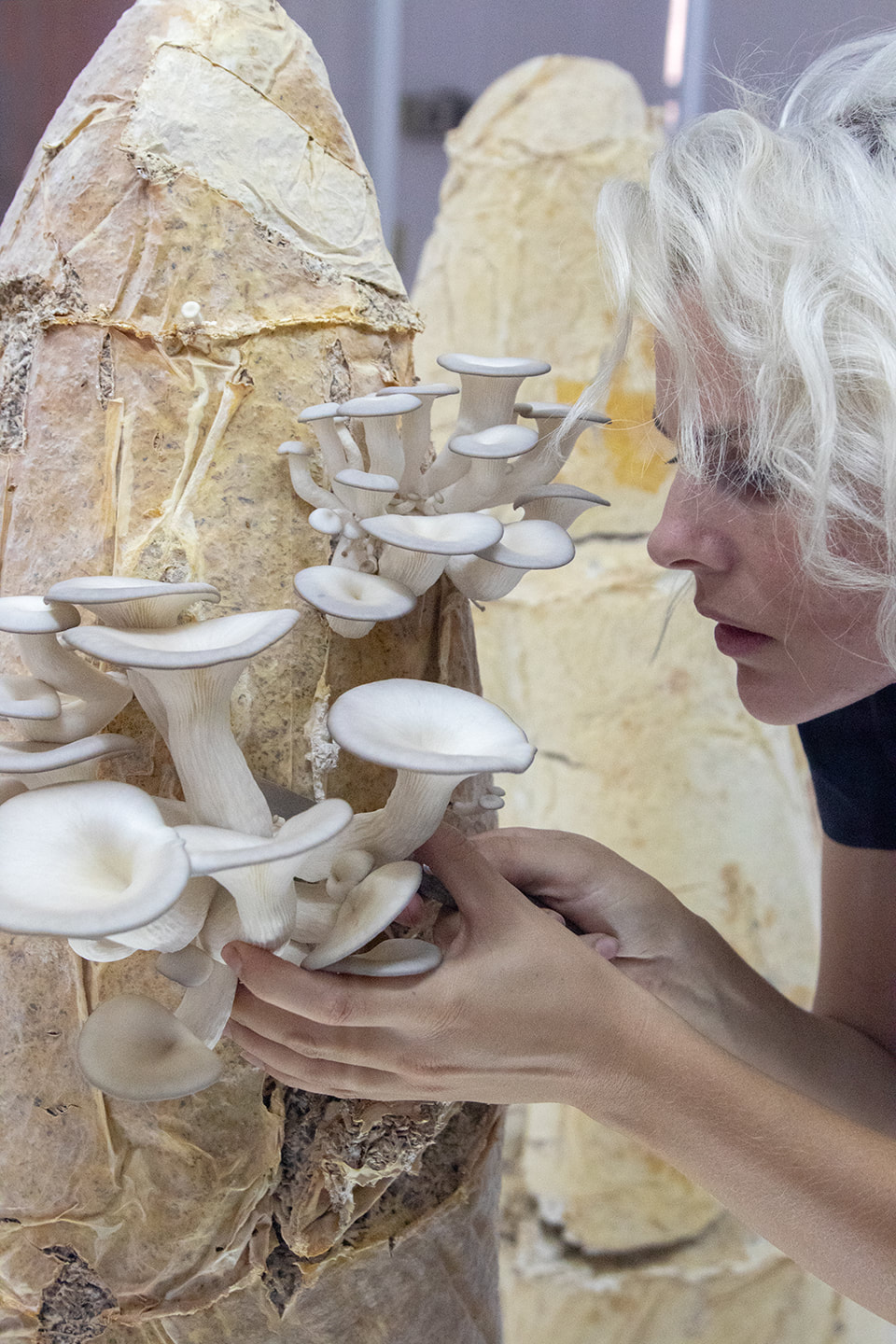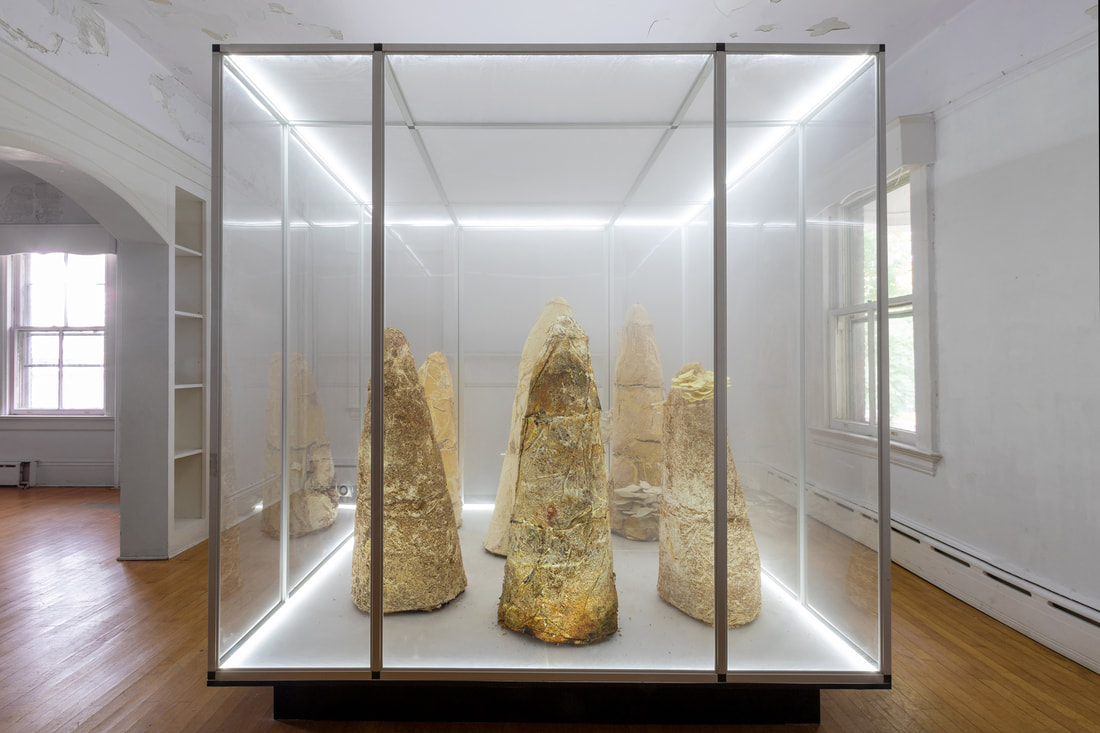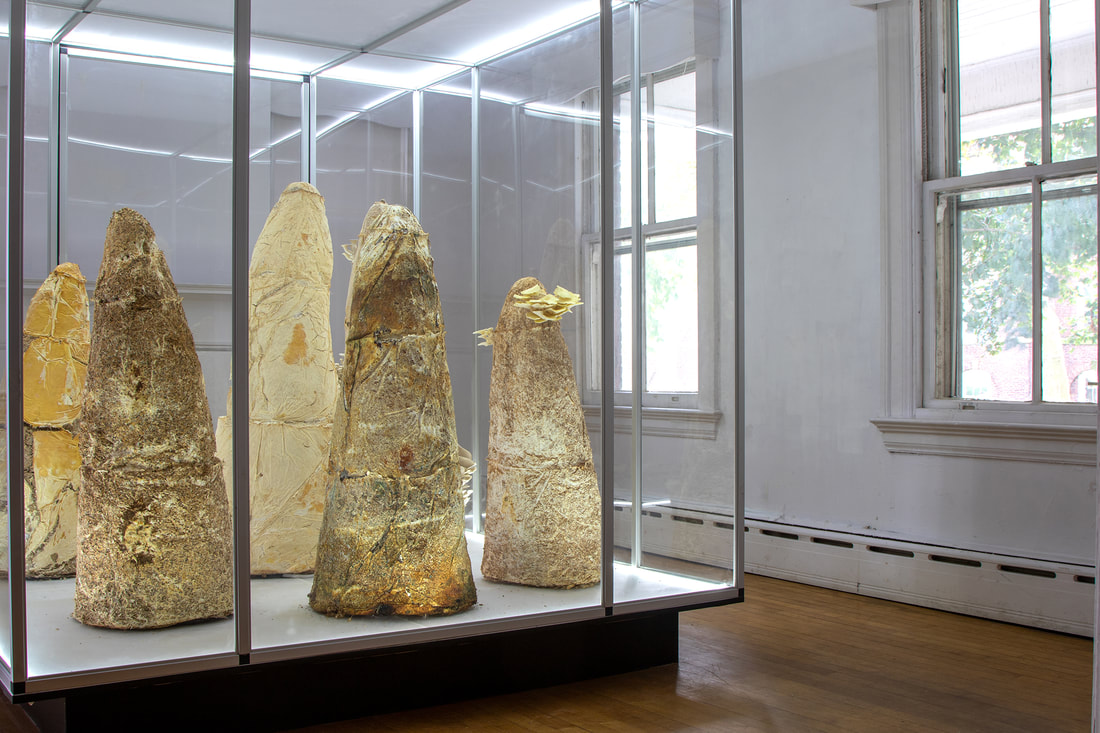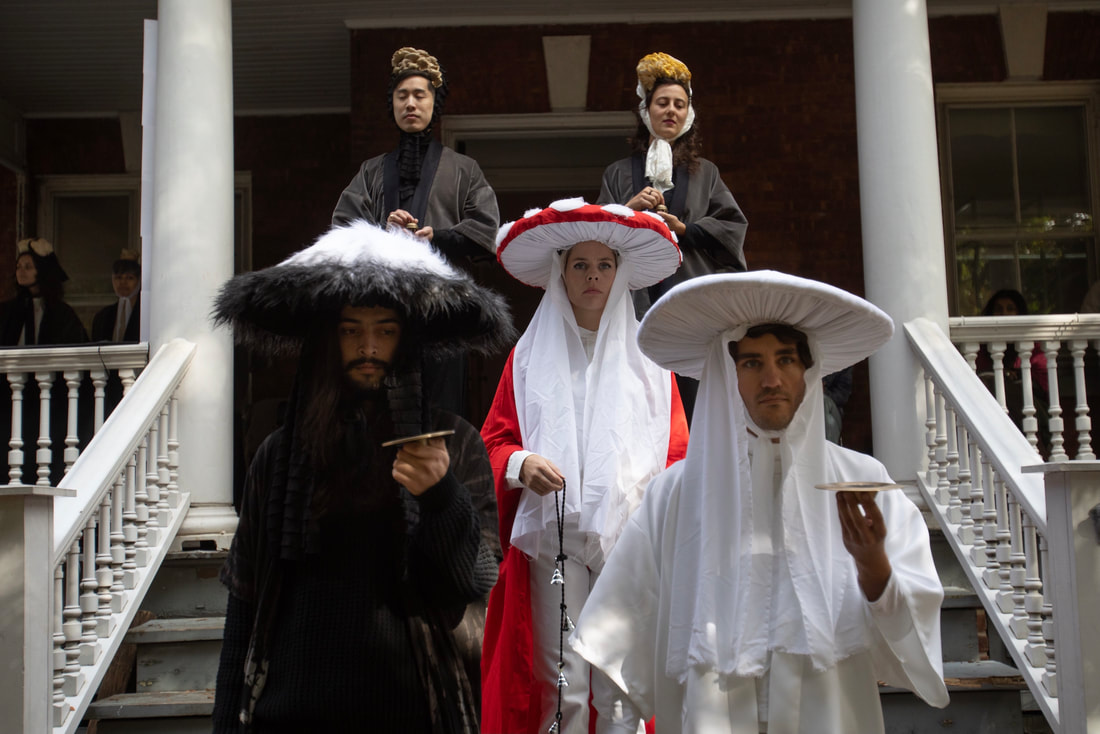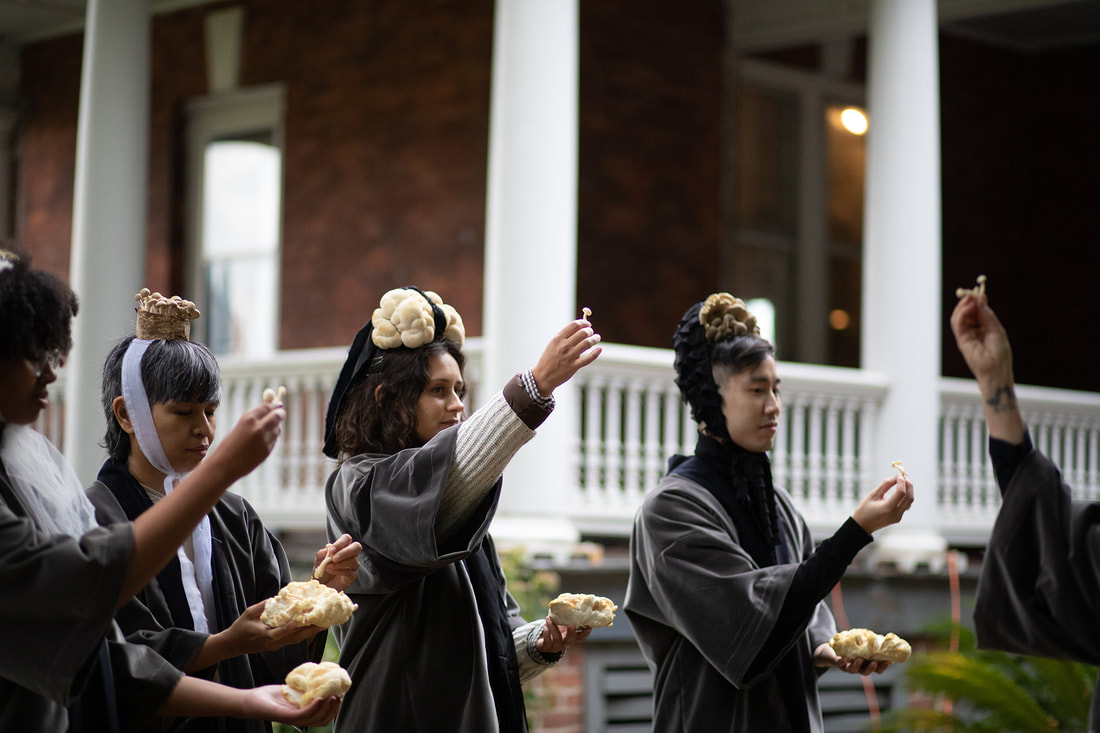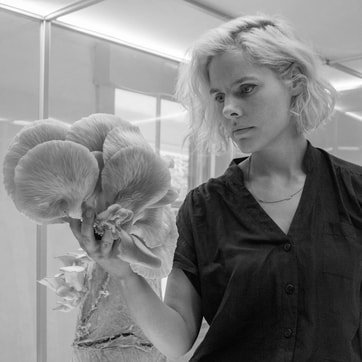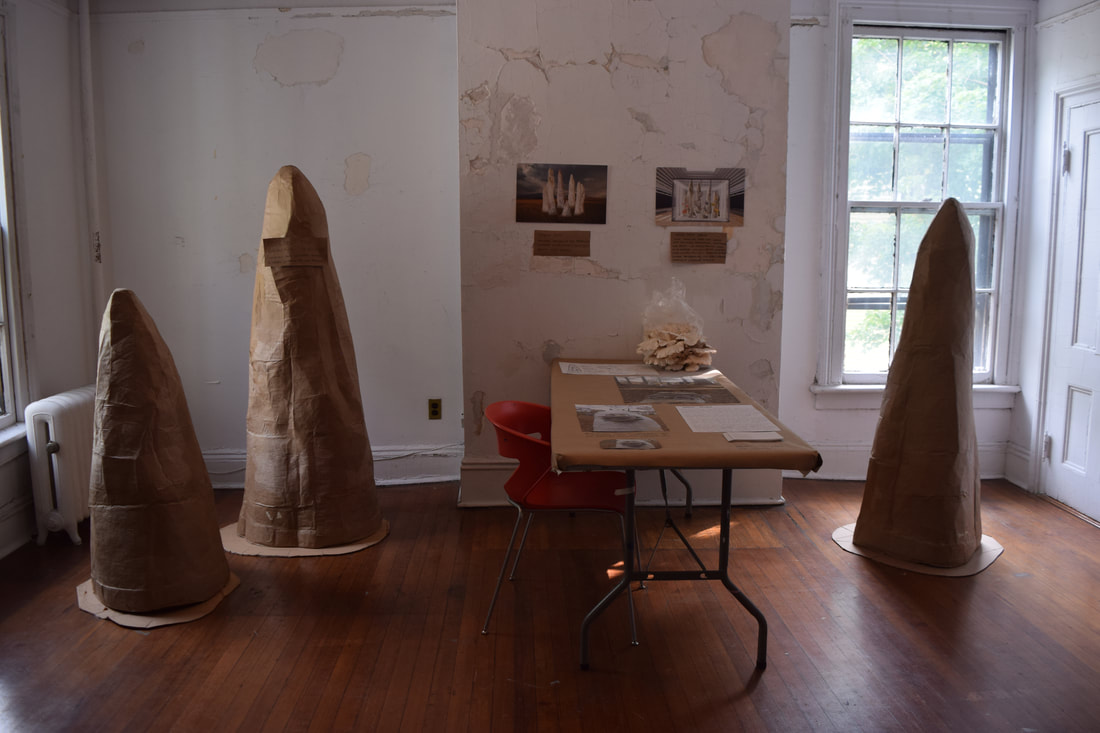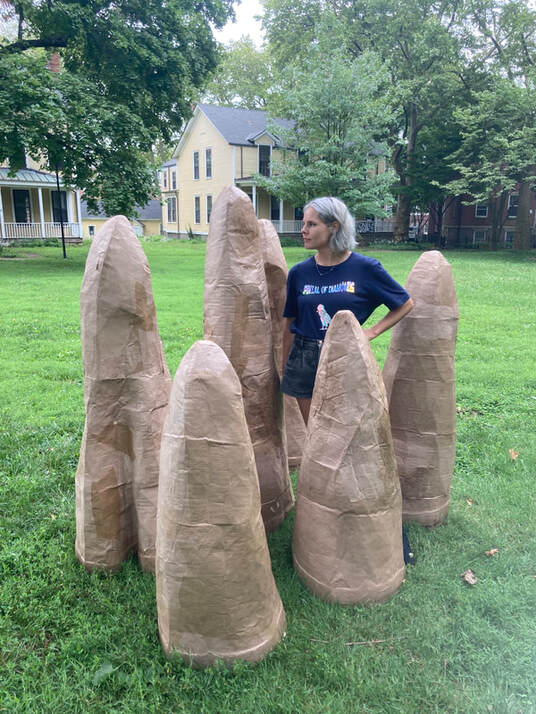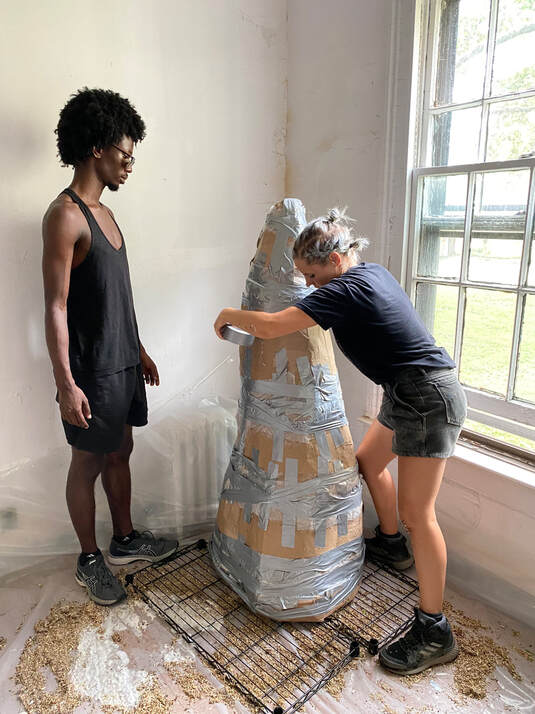Jemila MacEwan is known for their intimately interwoven earthworks, sculptures, films and performances that build a contemporary mythology of meteorites, volcanoes, prehistoric super-fungi and melting glaciers. These stories engage with the emotional complexity of humanity’s destructive impact, to the planet and to itself. MacEwan's work is empathetic to the psychological pressure of trying to reach into the past to regain control of a future fraught with uncertainty.
MacEwan is a recipient of The Marten Bequest Travelling Scholarship 2020. They received a Master of Contemporary Art at the University of Melbourne, Australia. They have performed and exhibited extensively internationally including; ARoS Museum (Denmark), The Australian Consulate-General (NYC), Pioneer Works (NYC), Victori+MO (NYC), The Elizabeth Foundation for the Arts (NYC), NYCXDESIGN (USA), BRIC Biennial III (NYC), Skaftfell Center for Visual Art (Iceland) and The Castlemaine State Festival (Australia). They have been invited to attend many residencies notably; BANFF Center for Arts and Creativity (Canada), NARS Foundation (NYC), Ox-Bow School of Painting (MI), Sculpture Space (NY), and is the founder of the performance process residency Land Falls (NY). They have been invited to host and participate in public talks and discussions on themes of intercultural practice, mental health, contemporary animism and environmental accountability. MacEwan has been generously supported by the Foundation for Contemporary Arts, The Australia Council for the Arts, New York Foundation for the Arts, Café Royal Foundation, the Dame Joan Sutherland Fund, the Ian Potter Cultural Council and the Graduate Women of Victoria.
MacEwan is a recipient of The Marten Bequest Travelling Scholarship 2020. They received a Master of Contemporary Art at the University of Melbourne, Australia. They have performed and exhibited extensively internationally including; ARoS Museum (Denmark), The Australian Consulate-General (NYC), Pioneer Works (NYC), Victori+MO (NYC), The Elizabeth Foundation for the Arts (NYC), NYCXDESIGN (USA), BRIC Biennial III (NYC), Skaftfell Center for Visual Art (Iceland) and The Castlemaine State Festival (Australia). They have been invited to attend many residencies notably; BANFF Center for Arts and Creativity (Canada), NARS Foundation (NYC), Ox-Bow School of Painting (MI), Sculpture Space (NY), and is the founder of the performance process residency Land Falls (NY). They have been invited to host and participate in public talks and discussions on themes of intercultural practice, mental health, contemporary animism and environmental accountability. MacEwan has been generously supported by the Foundation for Contemporary Arts, The Australia Council for the Arts, New York Foundation for the Arts, Café Royal Foundation, the Dame Joan Sutherland Fund, the Ian Potter Cultural Council and the Graduate Women of Victoria.
Published on May 19th, 2022. Artist responses collected in months previous.
What are you currently excited about in your art practice?
Over the past few years my ideas have remained conceptually simple while becoming technically more complex. Working in the solitary way that I’m used to is no longer practical and I have expanded my working process to include more collaborators, fabricators and assistants. I have been moved by the investment of others to share the creative responsibility of bringing these ideas into reality. This has had the effect of dissolving any specific egoic ownership I feel about my projects, giving me a sense of relief and trust in the creative community. My performance works have recently involved a great deal of cross-disciplinary collaboration. For instance, to create a truly multi-sensorial experience for Mycelium Meditation I collaborated with two musicians (Matt Evans and Jack Helfrich) and food-artist duo Cosmophage (Jemma Brown and Jimmy Tran). Though I was the director and writer, the collaboration itself was creatively horizontal – each collaborator expanded the work imaginatively within their own discipline. I am excited to keep working with these collaborators and open up my process to even more cross-disciplinary modes of creation.
What were some of the challenges you faced last year as an artist? Was your work/ art practice affected by the pandemic this year, if so how?
In 2020, I extended myself into two new and highly challenging sculptural processes - growing sculptures from mycelium and casting a massive subterranean concrete form. In both cases I really needed a lot of physical assistance, but the pandemic restricted the number of people I could be working with at any one time. I ended up totally over-extended and burnt out by these projects, and even sustained injuries to both my wrists which made it even harder to do the work.
2021 has been very different because the vaccine has made conditions safer and restrictions have been more relaxed. I could bring on as much support as I needed; this year I hired a full time assistant and fabricators. It also made it possible to have larger audiences and show work indoors.
What does a typical day in the studio (or wherever you're making work) look like for you these days? What time of day are you at your studio, what are your studio must haves (ex: music, coffee, tools, etc), and what does your creative space look like?
There is no typical day in my art life. I work project to project and each part of the process is always very specific to the work I am making. I have more of a seasonal routine where I tend to do most of my physical work outside during the warmer months and the admin, planning and project writing in the winter.
I don’t work in a consistent studio environment – many of my projects are created in residency environments and I select the residencies based on the specific facilities or landscapes they give me access to. When I’m not at a residency, I do all of my admin and writing at home – I live in an archetypal Brooklyn loft with big windows, a million plants, lots of art, rock collections, dilapidated utilities, etc. It's just one big room that I share with my meteorologist partner who has also been working from home since the beginning of the pandemic and my cat.
What resources for artists have you found helpful that may be helpful for other artists?
An invisible part of my practice is the attention I give to emotional processing, and there are times when I am completely overwhelmed by it. As someone who is emotionally receptive all the time, cranio sacral therapy has been indispensable to my well being as an artist. This is a somatic-based therapy that sits somewhere between meditation, energy work and talk therapy. I began cranio sacral therapy in 2018 with practitioner Holly Sass, when I felt hopelessly depressed whilst working on a project that confronted environmental grief. Over several months of therapy I was able to find stability again.
This year I worked on the second iteration of a mycelial collaboration called ‘Dead Gods’. Working with live fungi has been more emotionally confronting than any other process I’ve experienced. The lessons that come from my encounters with the fungi and the emotions that arise are what brings spiritual depth to this work. But staying with some of the more painful and uncomfortable emotions such as anxiety, fear, and heartbreak can be immensely fatiguing and it can be tempting to disengage. Cranio sacral therapy has helped me focus and ground these experiences, especially when they become overwhelming.
What in your art career are you looking forward to in the upcoming year? Do you have any specific goals or projects in mind?
I was awarded the BigCi Environmental Award which is a commission to create a new work in the World Heritage-listed Greater Blue Mountains in Australia. I’ll be travelling there in January to create a project entitled ‘Breathing Rock’. This idea was conceived during the immense fires that consumed Australia in early 2020. I felt I wanted to find a way to create a work that was about restoration that was gentle and playful.
I am working on the final component to a permanent acoustic earthwork at Lacasapark, NY entitled ‘Temple,’ which started in 2019. The final phase of the work is the creation of a glass capstone for which I am working with the RIT Glass department.
After this I will be travelling to Taos, NM to work on a community project called ‘Sun Seeds.’ I will be working with the local community to create hundreds of sun-reflecting kites which we will fly together in the desert.
I'm also working on my first survey exhibition in Maine in the Fall of 2022, and I am working as a designer on the dance production ‘Call to Remember’ for Leslie Parker to be held in the Walker Art Centre, in 2023.
What are you currently excited about in your art practice?
Over the past few years my ideas have remained conceptually simple while becoming technically more complex. Working in the solitary way that I’m used to is no longer practical and I have expanded my working process to include more collaborators, fabricators and assistants. I have been moved by the investment of others to share the creative responsibility of bringing these ideas into reality. This has had the effect of dissolving any specific egoic ownership I feel about my projects, giving me a sense of relief and trust in the creative community. My performance works have recently involved a great deal of cross-disciplinary collaboration. For instance, to create a truly multi-sensorial experience for Mycelium Meditation I collaborated with two musicians (Matt Evans and Jack Helfrich) and food-artist duo Cosmophage (Jemma Brown and Jimmy Tran). Though I was the director and writer, the collaboration itself was creatively horizontal – each collaborator expanded the work imaginatively within their own discipline. I am excited to keep working with these collaborators and open up my process to even more cross-disciplinary modes of creation.
What were some of the challenges you faced last year as an artist? Was your work/ art practice affected by the pandemic this year, if so how?
In 2020, I extended myself into two new and highly challenging sculptural processes - growing sculptures from mycelium and casting a massive subterranean concrete form. In both cases I really needed a lot of physical assistance, but the pandemic restricted the number of people I could be working with at any one time. I ended up totally over-extended and burnt out by these projects, and even sustained injuries to both my wrists which made it even harder to do the work.
2021 has been very different because the vaccine has made conditions safer and restrictions have been more relaxed. I could bring on as much support as I needed; this year I hired a full time assistant and fabricators. It also made it possible to have larger audiences and show work indoors.
What does a typical day in the studio (or wherever you're making work) look like for you these days? What time of day are you at your studio, what are your studio must haves (ex: music, coffee, tools, etc), and what does your creative space look like?
There is no typical day in my art life. I work project to project and each part of the process is always very specific to the work I am making. I have more of a seasonal routine where I tend to do most of my physical work outside during the warmer months and the admin, planning and project writing in the winter.
I don’t work in a consistent studio environment – many of my projects are created in residency environments and I select the residencies based on the specific facilities or landscapes they give me access to. When I’m not at a residency, I do all of my admin and writing at home – I live in an archetypal Brooklyn loft with big windows, a million plants, lots of art, rock collections, dilapidated utilities, etc. It's just one big room that I share with my meteorologist partner who has also been working from home since the beginning of the pandemic and my cat.
What resources for artists have you found helpful that may be helpful for other artists?
An invisible part of my practice is the attention I give to emotional processing, and there are times when I am completely overwhelmed by it. As someone who is emotionally receptive all the time, cranio sacral therapy has been indispensable to my well being as an artist. This is a somatic-based therapy that sits somewhere between meditation, energy work and talk therapy. I began cranio sacral therapy in 2018 with practitioner Holly Sass, when I felt hopelessly depressed whilst working on a project that confronted environmental grief. Over several months of therapy I was able to find stability again.
This year I worked on the second iteration of a mycelial collaboration called ‘Dead Gods’. Working with live fungi has been more emotionally confronting than any other process I’ve experienced. The lessons that come from my encounters with the fungi and the emotions that arise are what brings spiritual depth to this work. But staying with some of the more painful and uncomfortable emotions such as anxiety, fear, and heartbreak can be immensely fatiguing and it can be tempting to disengage. Cranio sacral therapy has helped me focus and ground these experiences, especially when they become overwhelming.
What in your art career are you looking forward to in the upcoming year? Do you have any specific goals or projects in mind?
I was awarded the BigCi Environmental Award which is a commission to create a new work in the World Heritage-listed Greater Blue Mountains in Australia. I’ll be travelling there in January to create a project entitled ‘Breathing Rock’. This idea was conceived during the immense fires that consumed Australia in early 2020. I felt I wanted to find a way to create a work that was about restoration that was gentle and playful.
I am working on the final component to a permanent acoustic earthwork at Lacasapark, NY entitled ‘Temple,’ which started in 2019. The final phase of the work is the creation of a glass capstone for which I am working with the RIT Glass department.
After this I will be travelling to Taos, NM to work on a community project called ‘Sun Seeds.’ I will be working with the local community to create hundreds of sun-reflecting kites which we will fly together in the desert.
I'm also working on my first survey exhibition in Maine in the Fall of 2022, and I am working as a designer on the dance production ‘Call to Remember’ for Leslie Parker to be held in the Walker Art Centre, in 2023.
Find Jemila MacEwan on Instagram
